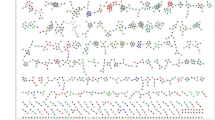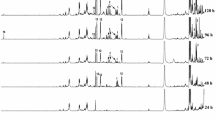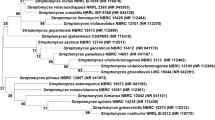Abstract
In this research, a microbial endophytic strain obtained from the rhizosphere of the conifer Taxus baccata and designated as Streptomyces sp. AC35 (FJ001754.1 Streptomyces, GenBank) was investigated. High 16S rDNA gene sequence similarity suggests that this strain is closely related to S. odorifer. The major fatty acid profile of intracellular lipids was also carried out to further identify this strain. Atomic force microscopy and scanning acoustic microscopy were used to image our strain. Its major excreted substances were extracted, evaluated for antimicrobial activity, purified, and identified by ultraviolet–visible spectroscopy (UV–vis), liquid chromatography–mass spectrometry (LC–MS/MS) and nuclear magnetic resonance as the bioactive isoflavone aglycones—daidzein, glycitein and genistein. Batch cultivation, performed under different pH conditions, revealed enhanced production of antimycin components when the pH was stable at 7.0. Antimycins were detected by HPLC and identified by UV–vis and LC–MS/MS combined with the multiple reaction monitoring. Our results demonstrate that Streptomyces sp. AC35 might be used as a potential source of effective, pharmaceutically active compounds.









Similar content being viewed by others
References
Takahashi Y, Omura S (2003) Isolation of new actinomycete strains for the screening of new bioactive compounds. J Gen Appl Microbiol 49:141–154
Narayana KJP, Vijayalakshmi M (2008) Optimization of antimicrobial metabolites production by Streptomyces albidoflavus. Res J Pharmacol 2(1):4–7
Saadoun I, AL-Joubori B, Al-Khoury R (2015) Testing of production of inhibitory bioactive compounds by soil streptomycetes as preliminary screening programs in UAE for anti-cancer and anti-bacterial drugs. Int J Curr Microbiol Appl Sci 4(3):446–459
Yilmaz EI, Yavuz M, Kizil M (2008) Molecular characterization of rhizospheric soil streptomycetes isolated from indigenous Turkish plants and their antimicrobial activity. World J Microbiol Biotechnol 24:1461–1470
Lee EJ, Hwang KY, Lee H, Chung N (2011) Characterization of a new Streptomyces sp. A1022 as a potential biocontrol agent. J Korean Soc Appl Biol Chem 54(3):488–493
Hu SC, Hong K, Song YC, Liu JY, Tan RX (2009) Biotransformation of soybean isoflavones by a marine Streptomyces sp. 060524 and cytotoxicity of the products. World J Microbiol Biotechnol 25:115–121
Osman ME, Ahmed FH, Abd El All WSM (2011) Antibiotic production from local Streptomyces isolates from Egyptian soil at Wady ElNatron: isolation, identification and optimization. Aust J Basic Appl Sci 5(9):782–792
Berdy J (1995) Are actinomycetes exhausted as a source of secondary metabolites? In: Proceedings of the 9th international symposium on the biology of actinomycetes, part I. New York, pp 3–23
Berdy J (2005) Bioactive microbial metabolites. J Antibiot 58:1–26
Bouizgarne B, Lanoot B, Loqman S, Sproer C, Klenk HP, Swings J, Ouhdouch Y (2009) Streptomyces marokkonensis sp. nov., isolated from rhizosphere soil of Argania spinosa L. Int J Syst Evolution Microbiol 59:2857–2863
Lo FH, Mak NK, Leung KN (2007) Studies on the anti-tumor activities of the soy isoflavone daidzein on murine neuroblastoma cells. Biomed Pharmacother 61:591–595
Miura T, Yuan L, Sun B, Fujii H, Yoshida M, Wakame K, Kosuna K (2002) Isoflavone aglycon produced by culture of soybean extracts with basidiomycetes and its anti-angiogenic activity. Biosci Biotechnol Biochem 66(12):2626–2631
Hintz KK, Ren J (2004) Phytoestrogenic isoflavones daidzein and genistein reduce glucose-toxicity-induced cardiac contractile dysfunction in ventricular myocytes. Endocr Res 30(2):215–223
Nishii T, Inai M, Kaku H, Horikawa M, Tsunoda T (2007) A practical total synthesis of (+)-antimycin A9. J Antibiot 60(1):65–72
Shiomi K, Hatae K, Hatano H, Matsumoto A, Takahashi Y, Jiang CL, Tomoda H, Kobayashi S, Tanaka H, Omura S (2005) A new antibiotic, antimycin A9, produced by Streptomyces sp. K01-0031. J Antibiot 58(1):74–78
Viegelmann C, Margassery LM, Kennedy J, Zhang T, O´Brien C, O´Gara F, Morrissey JP, Dobson ADW, Edrada-Ebel R (2014) Metabolomic profiling and genomic study of a marine sponge-associated Streptomyces sp. Mar Drugs 12:3323–3351
Xu LY, Quan XS, Wang C, Sheng HF, Zhou GX, Lin BR, Jiang RW, Yao XS (2011) Antimycins A19 and A20, two new antimycins produced by marine actinomycete Streptomyces antibioticus H74-18. J Antibiot 64:661–665
Kumar S, Tamura K, Nei M (2004) MEGA3: integrated software for molecular evolutionary genetics analysis and sequence alignment. Brief Bioinf 5:150–163
Christopherson SW, Glass RL (1969) Preparation of milk fat methyl esters by alcoholysis in an essentially non-alcoholic solution. J Dairy Sci 52:1289–1290
Maruna M, Sturdikova M, Liptay T, Godany A, Muckova M, Certik M, Pronayova N, Proksa B (2010) Isolation, structure elucidation and biological activity of angucycline antibiotics from an epiphytic yew streptomycete. J Basic Microbiol 50:1–8
Bradford MM (1976) A rapid and sensitive method for the quantitation of microgram quantities of protein utilizing the principle of protein-dye binding. Anal Biochem 72:248–254
Maleki H, Mashinchian O (2011) Characterization of Streptomyces isolates with UV, FTIR spectroscopy and HPLC analyses. BioImpacts 1(1):47–52
Del Sol R, Armstrong I, Wright C, Dyson P (2007) Characterization of Changes to the cell surface during the life cycle of Streptomyces coelicolor. atomic force microscopy of living cells. J Bacteriol 189:2219–2225
Hain T, Ward-Rainey N, Kroppenstedt RM, Stackebrandt E, Rainey FA (1997) Discrimination of Streptomyces albidoflavus strains based on the size and number of 16–23 s ribosomal DNA intergenic spacers. Int J Syst Bacteriol 47(1):202–206
Mergaert J, Wouters A, Swings J (1994) Estimation of the intrinsic biodiversity among poly(3-hydroxyalkanoates) degrading streptomycetes using gas chromatographic analysis of fatty acids. System Appl Microbiol 17:601–612
Seipke RF, Hutchins MI (2013) The regulation and biosynthesis of antimycins. Beilstein J Org Chem 9:2556–2563
Schneemann I, Nagel K, Kajahn I, Labes A, Wiese J, Imhoff JF (2010) Comprehensive investigation of marine Actinobacteria associated with the sponge Halichondria panacea. Appl Enviro Microbiol 76(11):3702–3714
Schilling G, Berti D, Kluepfel D (1970) Antimycin A components. II Identification and analysis of antimycin A fractions by pyrolysis-gas liquid chromatography. J Antibiot 23(2):81–91
Hosotani N, Kumagai K, Nakagawa H, Shimatani T, Saji I (2005) Antimycins A10–A16, seven new antimycin antibiotics produced by Streptomyces spp. SPA-10191 and SPA-8893. J Antibiot 58(7):460–467
Abidi SL (1989) Reversed-phase thin-layer chromatography of homologues of antimycin A and related derivatives. J Chromatogr 464:453–458
Verdrengh M, Vincent Collins L, Bergin P, Tarkowski A (2004) Phytoestrogen genistein as an antistaphylococcal agent. Microbes Infect 6:86–92
Ulanowska K, Tkaczyc A, Konopa G, Wegrzyn G (2006) Differential antibacterial activity of genistein arising from global inhibition of DNA, RNA and protein synthesis in some bacterial strain. Arch Microbiol 184:271–278
Ramachandran S, Gottlieb D (1961) Mode of action of antibiotics II. Specificity of action of antimycin A and ascosin. Biochim Biophys Acta 53(2):396–402
Kutzner HJ (1986) The family Streptomycetaceae. The prokaryotes, a handbook on habitats, isolation and identification of bacteria, vol 2. Springer, New York, pp 2028–2090
Author information
Authors and Affiliations
Corresponding author
Ethics declarations
Funding
This study was supported by VEGA Grants No. 1/0770/15 from Ministry of Education, Slovak Republic.
Conflict of interest
The authors declare that they have no conflict of interest.
Rights and permissions
About this article
Cite this article
Ondrejíčková, P., Šturdíková, M., Hushegyi, A. et al. Endophytic Streptomyces sp. AC35, a producer of bioactive isoflavone aglycones and antimycins. J Ind Microbiol Biotechnol 43, 1333–1344 (2016). https://doi.org/10.1007/s10295-016-1800-4
Received:
Accepted:
Published:
Issue Date:
DOI: https://doi.org/10.1007/s10295-016-1800-4




